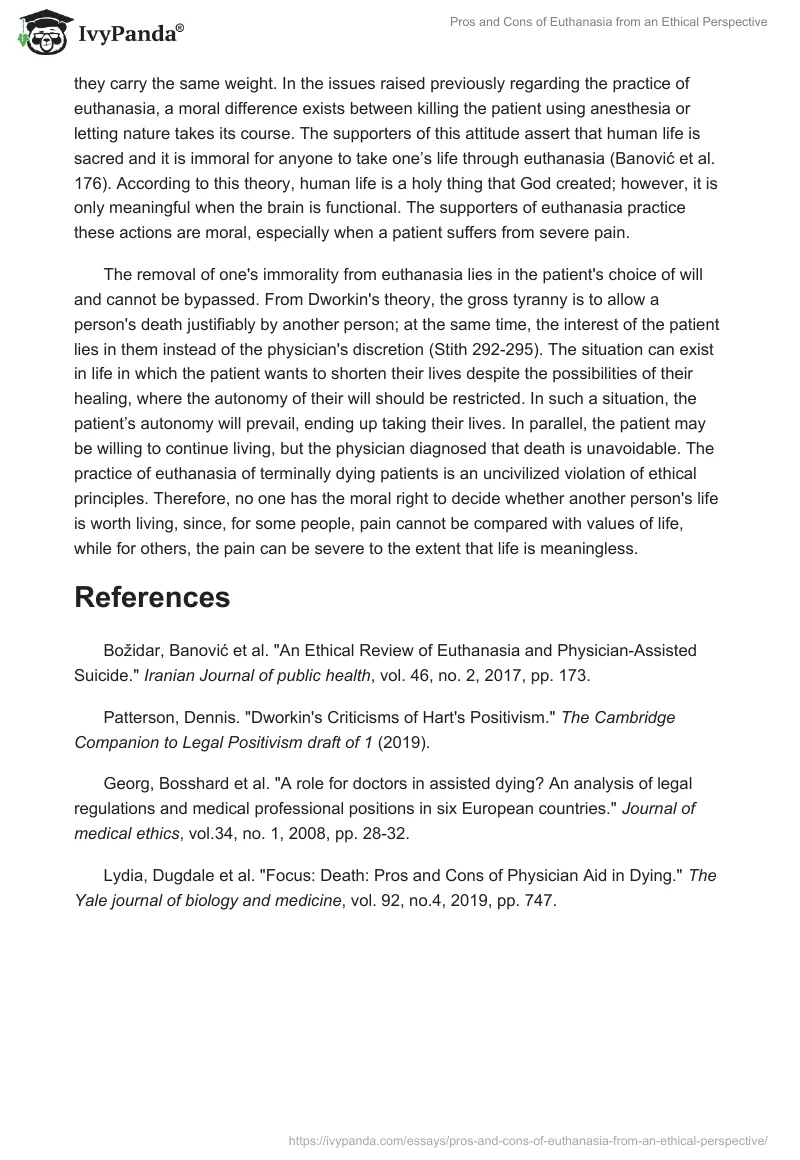Euthanasia is a controversial topic raising ethical concerns globally, such as whether a man has a right to dignified death or deprivation of life from a mercy reasons an unpunishable act. Answers to these questions differ from one state to another. If a state legalizes this form of life deprivation, it is questionable; conversely, taking an opposite view will also give rise to the same questions (Banović et al. 1). Therefore, euthanasia is an inexhaustible, hotly debated moral issue attracting different views, say pros and cons of legalizing euthanasia. Before arriving at the conclusion, I consulted Lydia, Dugdale et al. “Focus: Death: Pros and Cons of Physician Aid in Dying.” The Yale journal of biology and medicine, vol. 92, no.4, 2019, p.749. I believe that there are strong arguments in place both in opposition to and in favor of the practice of euthanasia; physicians have a moral responsibility to remain informed on this timely issue.
While the last two decades have been characterized by movements legalizing euthanasia, legislators worldwide have seemed to discriminate against it as a mild form of depriving life. Primarily, this is apparent on American soil, in which some states decriminalized euthanasia, although the supreme court maintained that there is no law that legalized the practice nor the ban of the mentioned act (Banović et al. 2). On the contrary, such actions attract strict critics, which ultimately seek to eliminate penalties for criminals who facilitate deprivation of the patient life, who is terminally ill at their request. For instance, the consistent variation in an attitude of the Royal college of Physicians and British Medical Association from strict opposition to a neutral position indicates it is challenging to accept their attitude encouraging terminating one’s life (Dennis 28). Although such practices are illegal in the countries in the world, they exist everywhere.
The right to die with dignity is inevitably associated with morality and ethics. One question typically arises: could ethical and moral conducts be legalized, but the act be immoral as per the law. In this context, if we begin with the basic rule, euthanasia is only a tiny part of morality; whereby moral rule is higher than legal rules. In this regard, when a legislator discourages euthanasia, they should not discriminate against them because they carry the same weight. In the issues raised previously regarding the practice of euthanasia, a moral difference exists between killing the patient using anesthesia or letting nature takes its course. The supporters of this attitude assert that human life is sacred and it is immoral for anyone to take one’s life through euthanasia (Banović et al. 176). According to this theory, human life is a holy thing that God created; however, it is only meaningful when the brain is functional. The supporters of euthanasia practice these actions are moral, especially when a patient suffers from severe pain.
The removal of one’s immorality from euthanasia lies in the patient’s choice of will and cannot be bypassed. From Dworkin’s theory, the gross tyranny is to allow a person’s death justifiably by another person; at the same time, the interest of the patient lies in them instead of the physician’s discretion (Stith 292-295). The situation can exist in life in which the patient wants to shorten their lives despite the possibilities of their healing, where the autonomy of their will should be restricted. In such a situation, the patient’s autonomy will prevail, ending up taking their lives. In parallel, the patient may be willing to continue living, but the physician diagnosed that death is unavoidable. The practice of euthanasia of terminally dying patients is an uncivilized violation of ethical principles. Therefore, no one has the moral right to decide whether another person’s life is worth living, since, for some people, pain cannot be compared with values of life, while for others, the pain can be severe to the extent that life is meaningless.
References
Božidar, Banović et al. “An Ethical Review of Euthanasia and Physician-Assisted Suicide.” Iranian Journal of public health, vol. 46, no. 2, 2017, pp. 173.
Patterson, Dennis. “Dworkin’s Criticisms of Hart’s Positivism.” The Cambridge Companion to Legal Positivism draft of 1 (2019).
Georg, Bosshard et al. “A role for doctors in assisted dying? An analysis of legal regulations and medical professional positions in six European countries.” Journal of medical ethics, vol.34, no. 1, 2008, pp. 28-32.
Lydia, Dugdale et al. “Focus: Death: Pros and Cons of Physician Aid in Dying.” The Yale journal of biology and medicine, vol. 92, no.4, 2019, pp. 747.


